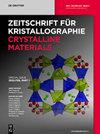Ni3Sn4 and FeAl2 as vacancy variants of the W-type (“bcc”) structure
IF 2.7
4区 材料科学
Q3 CRYSTALLOGRAPHY
Zeitschrift Fur Kristallographie-Crystalline Materials
Pub Date : 2023-08-01
DOI:10.1515/zkri-2023-0021
引用次数: 0
Abstract
Abstract Systematization of the vast number of known crystal structures of intermetallic phases is a challenge. One previously proposed group is referred to here as vacancy variants of the W-type structure. Members of this group, may, however, not be easily recognized because of the structural irregularity introduced by the vacancies. Descriptions of the experimentally observed crystal structures of Ni3Sn4 and FeAl2 in terms of vacancy variants of the W-type structure are, respectively, derived by establishing a lattice correspondence with the W-type structure, allowing, in particular, identification of the vacant sites. In both cases only small deviatoric strains are required to obtain the experimentally encountered lattice parameters, and generally small atomic displacements occur from the ideal positions, thus demonstrating significance of the lattice correspondence. The lattice correspondences allow, for both Ni3Sn4 and FeAl2, relating reported microstructure evidence (directions/planes occurring in orientation relationships and crystal habits but also on twinning and slip) with such typical for metals and solid solutions with W-type (“bcc”) structures. This demonstrates that the established lattice correspondences have a significance going beyond a descriptive one, but the underlying W-type structures reveal themselves in the materials’ behavior.Ni3Sn4和FeAl2作为W型(“bcc”)结构的空位变体
摘要金属间相的大量已知晶体结构的系统化是一个挑战。一个先前提出的组在这里被称为W型结构的空位变体。然而,由于空缺带来的结构不规则,这一群体的成员可能不容易被认可。Ni3Sn4和FeAl2的实验观察到的晶体结构在W型结构的空位变体方面的描述分别通过与W型结构建立晶格对应关系来导出,特别是允许空位的识别。在这两种情况下,只需要较小的偏应变就可以获得实验中遇到的晶格参数,并且通常从理想位置发生较小的原子位移,从而证明了晶格对应性的重要性。对于Ni3Sn4和FeAl2,晶格对应性允许将所报道的微观结构证据(在取向关系和结晶习性中出现的方向/平面,但也在孪晶和滑移中出现)与具有W型(“bcc”)结构的金属和固溶体的典型相关。这表明,建立的晶格对应关系具有超越描述性的意义,但潜在的W型结构在材料的行为中表现出来。
本文章由计算机程序翻译,如有差异,请以英文原文为准。
求助全文
约1分钟内获得全文
求助全文
来源期刊

Zeitschrift Fur Kristallographie-Crystalline Materials
CRYSTALLOGRAPHY-
CiteScore
2.00
自引率
16.70%
发文量
55
期刊介绍:
Zeitschrift für Kristallographie – Crystalline Materials was founded in 1877 by Paul von Groth and is today one of the world’s oldest scientific journals. It offers a place for researchers to present results of their theoretical experimental crystallographic studies. The journal presents significant results on structures and on properties of organic/inorganic substances with crystalline character, periodically ordered, modulated or quasicrystalline on static and dynamic phenomena applying the various methods of diffraction, spectroscopy and microscopy.
 求助内容:
求助内容: 应助结果提醒方式:
应助结果提醒方式:


